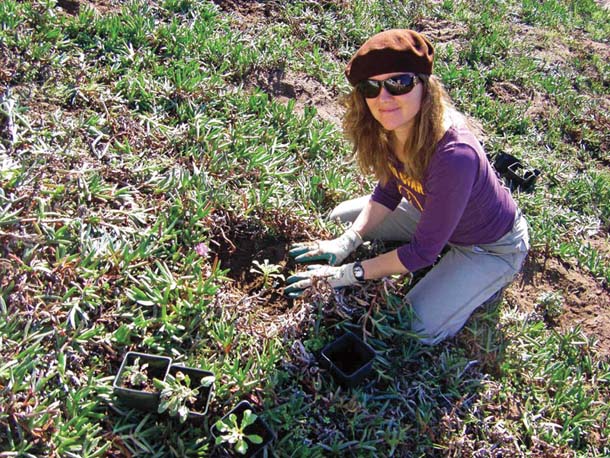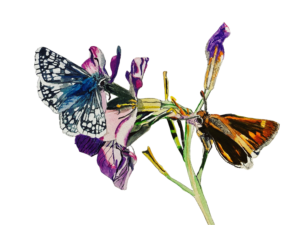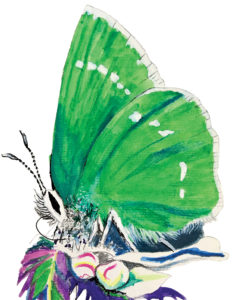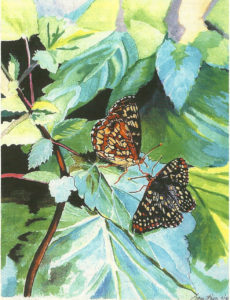It has been said that the movement of a butterfly’s wings can change the course of world events. Hopefully in the case of the green hairstreak, this is true. While most San Franciscans will never see this diminutive butterfly, and even serious naturalists are likely to overlook it, the coastal green hairstreak (Callophrys dumetorum) once occurred throughout much of San Francisco’s unique dune and rocky bluff habitats.
But during the first half of the last century, these habitats were gobbled up by development with an all-you-can-eat, conveyor-belt-like efficiency.
The surviving hairstreak populations were left stranded on a series of islands that included Twin Peaks, Glen Canyon, and Bayview Hill. In recent years, intrusion, fragmentation, and degradation of the remaining habitat has pushed these populations to the brink of extinction, a disheartening and increasingly familiar pattern.
Today in San Francisco, green hairstreaks can be found in only a few spots, including the restored dune and bluff habitats of the Presidio and on two hilltops in the Golden Gate Heights neighborhood of the inner Sunset.
- Green Hairstreak Project committee member Deirdre Elmansoumi plants hairstreak host plants in the inner Sunset. Photo by Liam O’Brien.
Up here, avenues and streets from the grid-like flatlands to the west collide in a maze of confused, random intersections. This is where San Francisco artist and ardent amateur lepidopterist Liam O’Brien is enlisting backyard gardeners and other residents in his quest to help the hairstreak stage a comeback.
When he’s prodded about why San Francisco should make an effort to save this scarcely detectable insect, O’Brien’s passion flares. “This is a creature that has flown since before the dawn of man,” he says. “Perhaps it will disappear, but I want to be part of the generation that at least tried to do something. I want to be part of something positive.”
The disappearing act we call extinction is nothing new to San Francisco butterflies. In fact, the city renowned for its environmental awareness holds the dubious distinction of being the home of the first-ever-recorded butterfly extinction. Last seen in the Presidio in 1941, the Xerces blue once flew alongside the coastal green hairstreak.
Working with the nonprofit Nature in the City, the San Francisco Natural Areas Program, and the Department of Public Works, O’Brien created the Green Hairstreak Project, mobilizing neighbors to use their own yards to reunite the two isolated hilltop hairstreak populations at Rocky Outcrop and Hawk Hill.
Studies reveal that a lack of genetic mixing between isolated populations of the same species leads to inbreeding and eventual decline. O’Brien and his volunteers aim to prevent that outcome for the green hairstreak. “We are trying to create a corridor to link the two populations,” explains Alane Bowling, a local resident helping to lead the project.
Bowling has assembled and presented a plan for creating green hairstreak habitat on a steep, vacant lot at 15th Avenue and Pacheco. She was successful in getting the thumbs up from the Department of Public Works and convincing neighbors to go ahead with the idea. During the winter of 2008 volunteers put in the first 200 native plants. “Not only are we providing habitat for the green hairstreak, we are also beautifying our neighborhood,” she says.
Nature in the City’s Peter Brastow calls the project “a perfect opportunity to achieve our mission: restoring habitat for a rare species and connecting people to nature where they live.”
Other neighbors are planting the butterfly’s larval host plants, coastal buckwheat (Eriogonum latifolium) and deerweed (Lotus scoparius), as well as other native plants in their yards. While male green hairstreaks are territorial, gravid females are prone to wandering. Yards planted with natives can serve not only as new breeding habitat, but also as stepping stones to help connect the two isolated populations. The hope is that eventually these two populations may again become a single, stronger whole.
Humans have had a major impact on this tiny butterfly and its habitats. But in an interesting twist, now the butterfly has begun to have an impact on us. “People who don’t know each other can get together and do something really quite special,” Bowling says. “Not every neighborhood is so lucky to have the green hairstreak. This tiny butterfly has given us the sense of wild discovery right in our own yards.”
Nature in the City will hold green hairstreak walks on April 12, April 26, and May 9. RSVP and more info at www.natureinthecity.org.

.jpg)




